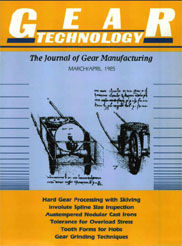The fundamental purpose of gear
grinding is to consistently and economically produce "hard" or "soft" gear tooth elements within the accuracy required by the gear functions. These gear elements include tooth profile, tooth spacing, lead or parallelism, axial profile, pitch line runout, surface finish, root fillet profile,
and other gear geometry which contribute
to the performance of a gear train.
